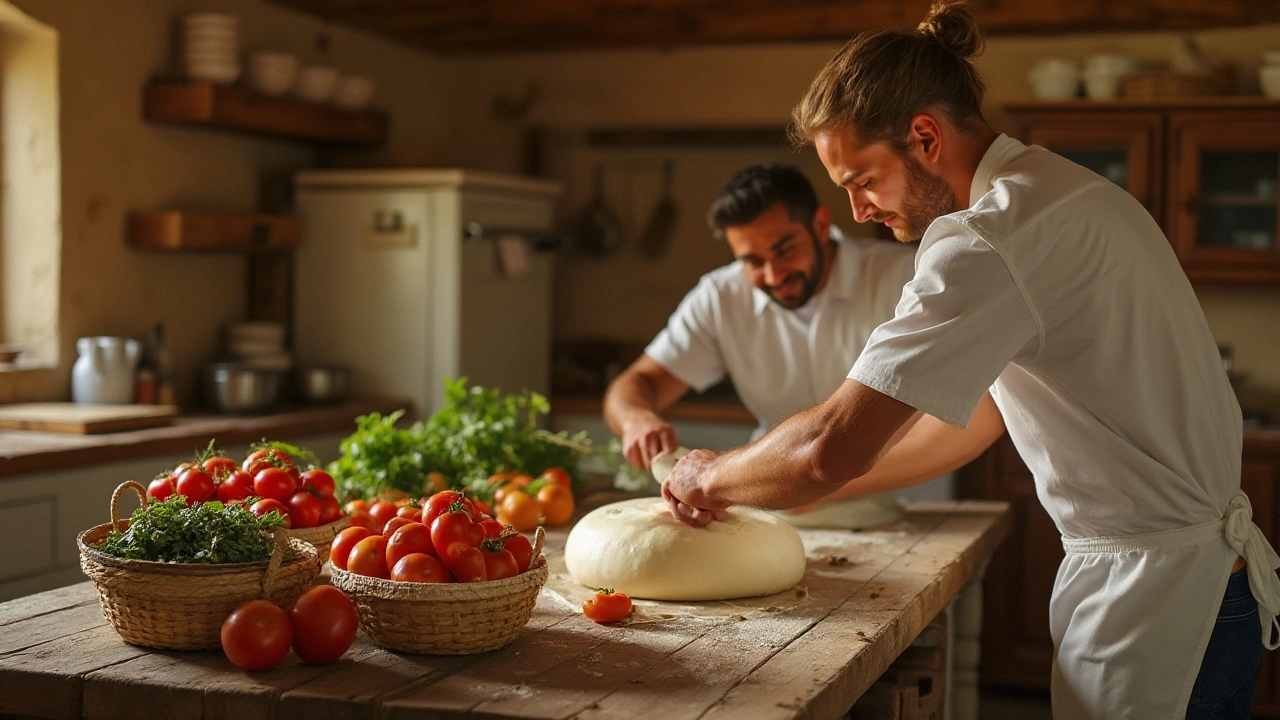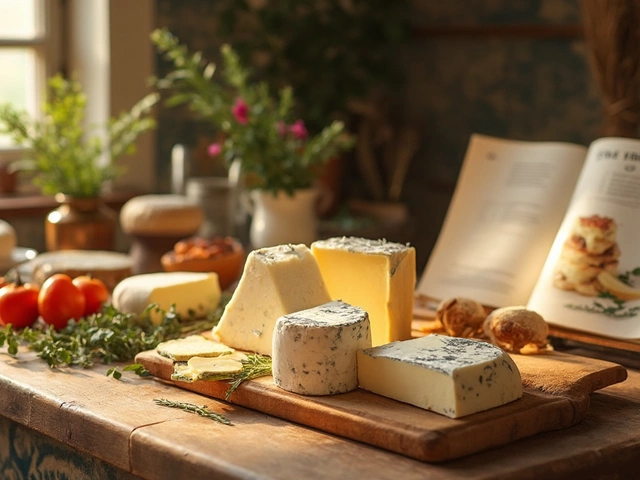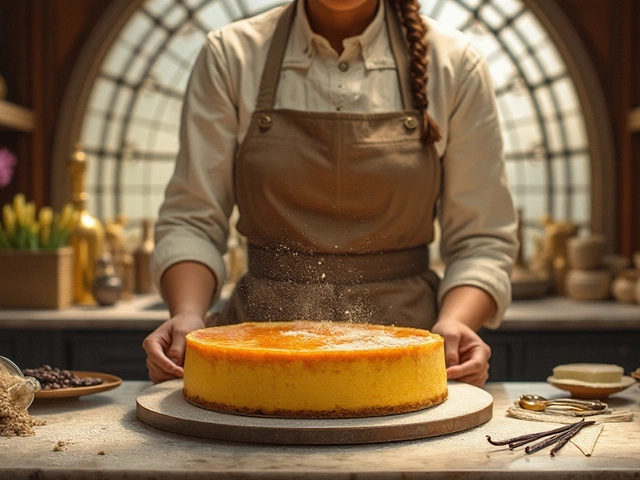
When you think about Italian cuisine, mozzarella probably comes to mind right after pizza or pasta. This soft, white cheese has made a significant impact around the culinary world. Yet, while it graces delicious pizzas and salads globally, its roots are deep in Italy, where it originated. But what does the word 'mozzarella' truly mean, and why is it so beloved?
Mozzarella is derived from the Italian verb 'mozzare,' which means 'to cut off.' An apt description, given how the cheese is traditionally made by cutting into the curd. The simplicity of its ingredients—milk, salt, and rennet—belies the complexity of its flavors and textures that vary depending on how it’s crafted. While originally made with buffalo milk, today it diversely features both cow and sometimes goat's milk.
While mozzarella shines as a centerpiece on pizzas and salads, it also has fascinating connections with other dishes. Take tiramisu, for example, where it plays a subtle background role, adding texture and richness. Mozzarella's creamy demeanor fits lovingly in both sweet and savory fare, demonstrating its versatility and integral place in Italian kitchens worldwide. Learning about these linkages offers us not just culinary insights, but also a deeper appreciation of cultural traditions.
- The Origins of Mozzarella Cheese
- The Cheese Making Process
- Mozzarella in Italian Cuisine
- The Unexpected Connection to Tiramisu
The Origins of Mozzarella Cheese
The story of mozzarella is as rich and captivating as the creamy cheese itself, steeped in the traditions of the Italian countryside. Initially crafted in the Campania region of southern Italy, mozzarella owes its origins to around the 12th century. This cheese is said to have originated when water buffalo were introduced to the fertile pastures around Naples. The locals soon discovered the rich, creamy milk produced by these animals, perfect for cheese-making. It was here, amid rolling hills and picturesque farmlands, that mozzarella began its journey to becoming a household staple across the globe.
This cheese was traditionally made exclusively from rich buffalo milk, known for its unique flavor and smooth texture. In the beginning, cheese makers would form mozzarella by stretching and kneading the curd in hot water—a process known as pasta filata—until it achieved just the right elasticity. This technique created cheese that was soft, moist, and delightfully stringy, characteristics that distinguished it from other similar cheeses. The name "mozzarella" itself is derived from the Italian word "mozzare," which means "to cut off," illustrated by the final step in this traditional cheese-making process, where the cheese is cut by hand.
Throughout history, the cheese carved its way into the hearts and kitchens of both urban dwellers and rustic villagers. By the 16th century, mozzarella had traveled far beyond its Campanian origin, with documentation of it appearing in diverse parts of Italy. It quickly became central to Italian culinary arts, eventually finding its iconic place atop the famous Neapolitan pizza. As time passed, cow's milk began substituting buffalo milk in some areas due to its availability, resulting in a lighter but still beloved version of this culinary gem.
Renowned for its versatility, historical sources speak to its significance in Italian food culture. "Mozzarella has been a staple long before the global fascination with pizza," notes the esteemed food historian Giovanni Ballarini.
Mozzarella was cherished during summer festivals when freshly made batches were often shared among close-knit communities.The cultural significance attached to mozzarella, from family celebrations to regional feasts, has only heightened its status in modern times. It's a nod to both tradition and innovation, adapting to culinary trends while maintaining its authentic roots.
To illustrate the mozzarella journey and its diverse variants, consider the production data from recent years. In a nutshell, buffalo mozzarella (or "mozzarella di bufala") is still celebrated, recognized by Italy’s DOP status (Denominazione di Origine Protetta), ensuring it is produced in traditional ways specific to certain areas. The table below shows recent production statistics as of 2023, highlighting the prominence of mozzarella in Italian exports and its growing demand globally.
| Year | Buffalo Mozzarella Production (tons) | Cow Milk Mozzarella Production (tons) |
|---|---|---|
| 2021 | 40,000 | 150,000 |
| 2022 | 45,000 | 160,000 |
| 2023 | 50,000 | 170,000 |
Thus, mozzarella stands as more than just a cheese; it embodies a taste of Italy’s landscape, history, and vibrant food culture. Its origins tell a tale of craftsmanship passed down generations, with each bite serving as an homage to a time-tested tradition.

The Cheese Making Process
The art of making mozzarella cheese has evolved from a humble farmhouse activity into a carefully regulated craft that is both captivating and intricate. The journey begins with the selection of the right milk, traditionally from water buffalo—a choice said to yield a richer and creamier texture compared to cow's milk. Freshness is key here, as milk is often used the same day it is collected. The process advances by heating the milk to a specific temperature, usually around 35 degrees Celsius, a step that helps activate the lactic bacteria often added to promote tartness and complexity.
Once the milk reaches the desired warmth, rennet is introduced. This marvelous enzyme causes the milk to coagulate, forming a solid mass called curd. Here is perhaps where most people unfamiliar with cheese-making would be surprised: the precision required in cutting the curd cannot be understated. It is typically sliced into small, neat cubes that allow whey, the translucent liquid portion, to seep out. The curds are then stretched and kneaded in hot water until they exhibit the desired elasticity—a physical transformation that is quite mesmerizing to observe. This part of the process, known in Italian as 'pasta filata,' is responsible for giving mozzarella its iconic stretch and softness.
"The magic of mozzarella lies in the transformation from curds to cheese, an age-old technique that brings families together," noted renowned cheese historian, Giovanni Fujicelli, in an interview with Cheeses of Europe Magazine.Salting follows, a simple yet pivotal step enhancing mozzarella's flavor while acting as a preservative. Cheese artisans demonstrate remarkable dexterity as they deftly form the cheese into familiar ball shapes, or bocconcini, depending on their intentions. But regardless of its guise, proper handling and storage remain essential aspects to savoring its freshest taste. Packaging the cheese in a brine-filled pouch helps retain its moisture and prized texture until it reaches the consumer, who often prefers it fresh, as dictated by Italian custom. Mozzarella offers a unique window into culinary tradition, revealing as much about human ingenuity as it does about taste and enjoyment.
For those venturing into making mozzarella at home, patience and respect for the traditional methods are essential. This endeavor can be made easier with quality ingredients, attention to detail, and a passion for capturing the authentic essence of Italian cuisine. Regardless of where one resides on the globe, crafting mozzarella enables a special connection to Italy's culinary heartland, allowing anyone to taste this timeless heritage.

Mozzarella in Italian Cuisine
The creamy joy of mozzarella cheese, eternally linked to Italy's culinary landscape, holds a special place on every Italian table. Witnessing the bright white balls of this cheese neatly set against the backdrop of olive wood cutting boards in a bustling kitchen is a sight to behold. It's a staple that embraces the rustic simplicity of Italian meals, from comforting home-cooked dishes to opulent restaurant menus.
The journey of mozzarella into the heart of Italian cuisine dates back to the regions of Campania and Naples, where it has been crafted for centuries. Mozzarella di bufala, specifically, hails from this part of Italy, showcasing the unique richness imparted by the milk of water buffalos. This variant brings with it an enviable creaminess and slightly tangy taste that is hard to resist and often finds its way into classic dishes like Caprese salad. Alongside sun-ripened tomatoes, fresh basil, and a drizzle of olive oil, mozzarella transforms these simple ingredients into a symphony of flavors.
Mozzarella cheese plays a key role in Italian pizzas, famous worldwide for their thin crusts and minimal toppings, allowing the cheese itself to shine. Pizza Margherita, with only three central ingredients—tomato, cheese, and basil—was even named after Queen Margherita of Savoy in the late 1800s, symbolizing the Italian flag with its red, white, and green hues. What makes it special is how this simple yet flavorful concoction unites textures; the dough's slight crunch, the tomato's saucy slickness, and mozzarella's milky melodious melting.
Looking beyond the familiar pizzas and salads, mozzarella dances into a myriad of unexpected Italian dishes, adding its lusciousness to baked pasta dishes and even desserts. Lasagna, that beloved layered wonder, gains an indulgent touch when studded with melting mozzarella among its layers of sauce and pasta sheets. Meanwhile, the adventurous dessert enthusiasts have found a way to integrate this cheese into unlikely dishes like mozzarella-stuffed dates drizzled with honey, bringing a salty-sweet experience.
"Like a gentle knight to the culinary world, mozzarella does not demand the limelight, but once it is in the mix, you cannot imagine the dish without it," says famous chef Lidia Bastianich.
Let's not forget that innovation never ceases in the kitchens of Italy. While mozzarella remains a symbol of tradition, creative chefs constantly experiment with its application, sometimes modernizing recipes with smoked mozzarella variations or even vegan options suitable for plant-based diets. Such adaptability showcases mozzarella's enduring compatibility with the evolving tastes while maintaining its gentle, creamy essence that transcends culinary boundaries.

The Unexpected Connection to Tiramisu
At first glance, it might seem that mozzarella would have little to do with a dessert like tiramisu. After all, one is a creamy cheese primarily associated with savory dishes, while the other is a decadent, coffee-flavored classic of Italian sweets. However, delve a bit deeper into the culinary traditions and variations that have surged over time, and you will find surprising intersections. Mozzarella's connection with creamy textures and subtle flavors can indeed play a part in elevating dishes such as tiramisu.
In some creative kitchens, mozzarella finds its way into desserts in unexpected forms. An intriguing innovation came when chefs sought to create a cheese base that would not overpower the other components of a sweet dish. By carefully choosing mild varieties of mozzarella, or when using burrata—a cousin of mozzarella known for its cream-filled core—cooks were able to incorporate this traditionally savory cheese into their sweet recipes, playing on its creamy attributes. There's a delightful cross-pollination happening in modern cuisines, where boundaries are often pushed to explore new tastes and textures.
Some chefs are also experimenting with transforming mozzarella into a sweet component by pairing it with ingredients like mascarpone or ricotta, both of which are essential to traditional tiramisu recipes. This approach adds an unexpected layer of flavor and texture, providing richness without overpowering the delicate balance of coffee, cocoa, and cream that defines tiramisu. An example of this can be seen in avant-garde culinary demonstrations, where flavor profiles are expanded, challenging our perceptions in delightful ways.
This culinary innovation underscores a key aspect of mozzarella: its astonishing versatility. Whether in a sumptuous salad, a slice of pizza oozing with melted cheese, or woven into a creamy, sweet tiramisu, this cheese proves remarkably adaptable. Known for its elegant and mild presence, mozzarella can become a canvas for creativity, extending even into dessert realms. Some culinary explorers have proposed that this versatility speaks to the broader theme of many Italian ingredients that straddle the line between the savory and the sweet.
"The beauty of traditional ingredients like mozzarella and how they can be manipulated into novel applications is truly exciting," says Julia Bittencourt, a renowned pastry chef known for her innovative takes on classic desserts. "It's about the juxtaposition of flavors and finding harmony in unexpected contrasts."
Such practices challenge the notion that cheeses like mozzarella are confined to specific categories of dishes. Instead, they highlight how the culinary arts are often about experimentation and embracing the potential of each ingredient to shine across different courses. This spirit of discovery not only enriches the evolution of recipe books but also delights food enthusiasts eager to savor something both familiar and novel. Breaking these barriers opens doors for home cooks and professional chefs alike, enhancing the narrative of what Italian cuisine can offer.












Write a comment